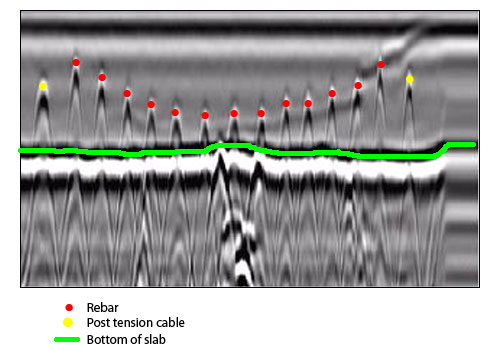Advanced Concrete Scanning Techniques: Ensuring Structural Stability
Advanced Concrete Scanning Techniques: Ensuring Structural Stability
Blog Article
Past the Surface: Leveraging Advanced Concrete Scanning Techniques for Unmatched Precision and Understanding
Advanced concrete scanning techniques have actually emerged as crucial devices in this pursuit, using a look beneath the surface to introduce a world of crucial insights. By taking advantage of advanced modern technologies, professionals can discover abnormalities, assess the condition of concrete frameworks, and make educated decisions that shape the course of projects.
Importance of Advanced Concrete Scanning
The significance of using sophisticated concrete scanning strategies depends on the exceptional accuracy they offer for spotting sub-surface anomalies and ensuring architectural integrity. By using advanced technologies such as ground-penetrating radar (GPR), electromagnetic induction, and progressed finder imaging, construction experts can dive under the surface area of concrete frameworks with a level of accuracy that much surpasses traditional evaluation techniques. Concrete Scanning. These methods enable the identification of covert hazards like rebar rust, gaps, conduits, or post-tension cables that could jeopardize the stability and safety and security of a structure over time
In addition, advanced concrete scanning supplies very useful insights right into the total problem of a concrete element without the need for invasive measures, minimizing the threat of creating damages during the assessment procedure. The capacity to identify the exact location and deepness of prospective issues enables targeted repair services and maintenance, inevitably lengthening the lifespan of the framework and enhancing its performance. Essentially, the relevance of innovative concrete scanning can not be overstated in the realm of building and framework maintenance, where accuracy and dependability are paramount.
Kinds of Cutting-Edge Technologies

Anomalies and Defect Discovery

Along with GPR, concrete scanning techniques like thermography and impact-echo testing are additionally efficient in identifying anomalies and problems. Thermography utilizes infrared technology to determine variants in surface area temperature level, suggesting prospective locations of worry such as delamination or dampness ingress. On the other hand, impact-echo testing entails assessing acoustic responses to detect voids, cracks, and other flaws within the concrete. By leveraging these sophisticated methods, experts can proactively deal with structural issues, ensuring the long life and safety and security of concrete frameworks.
Assessing Concrete Problem
Just how can designers accurately review the find more info condition of concrete structures to ensure their longevity and safety? Assessing the concrete condition is a vital element of keeping facilities honesty. Various sophisticated concrete scanning strategies are utilized for this purpose. Ground-penetrating radar (GPR) is generally utilized to assess the internal structure of concrete, identifying voids, fractures, and various other abnormalities that might endanger its stamina. In addition, impact-echo screening can offer insights right into the density and integrity of concrete elements. Ultrasonic pulse velocity testing is another important method for reviewing concrete top quality by gauging the rate of audio waves with the material.
Moreover, visual examination stays an essential part of concrete problem evaluation. Engineers visually examine the surface for indicators of damage, such as spalling, splitting, or discoloration. Incorporating non-destructive testing techniques with aesthetic evaluations enables for a thorough analysis of concrete condition, making it possible for designers to recognize potential issues early and carry out prompt maintenance or repair work. By leveraging these sophisticated methods, engineers can guarantee the long-lasting longevity and safety and security of concrete frameworks.
Enhancing Decision-Making Procedures
In the realm of infrastructure monitoring, enhancing decision-making processes is vital for guaranteeing the reliable upkeep and durability of concrete structures. Boosted decision-making processes in concrete management entail utilizing innovative scanning methods to collect thorough data on the problem of structures. hop over to these guys By leveraging modern technologies such as ground-penetrating radar and 3D imaging, stakeholders can make educated choices relating to repair, support, or replacement methods.
These progressed scanning techniques give indispensable insights into the inner composition of concrete, determining possible concerns such as voids, fractures, or corrosion that might not show up externally. This degree of comprehensive information enables proactive maintenance preparation, reducing the threat of architectural failings and raising the overall life-span of concrete frameworks.
Furthermore, by incorporating electronic paperwork and analysis devices right into the decision-making process, stakeholders can track the advancement of concrete problems over time, allowing predictive maintenance techniques and maximizing resource click to investigate allowance. Eventually, the combination of innovative concrete scanning strategies enhances decision-making procedures by supplying unmatched precision, understanding, and performance in facilities administration.
Final Thought
To conclude, advanced concrete scanning strategies supply unparalleled precision and understanding in finding anomalies, problems, and assessing the problem of concrete frameworks. By leveraging cutting-edge technologies, decision-making procedures can be improved, leading to even more educated and effective options for maintaining and fixing concrete facilities. These techniques play a crucial duty in making sure the safety and long life of concrete structures, making them a vital tool in the area of building and engineering.
Additionally, advanced concrete scanning gives indispensable insights right into the overall problem of a concrete element without the demand for invasive actions, reducing the threat of causing damages throughout the evaluation procedure - Concrete Scanning. One more cutting-edge innovation is 3D X-ray scanning, which gives comprehensive photos of the internal structure of concrete, supplying useful information without the requirement for devastating testing. Furthermore, Concrete Cover Meters are made use of to measure the thickness of concrete cover over support bars accurately. Improved decision-making procedures in concrete monitoring involve using innovative scanning techniques to gather in-depth information on the problem of structures.In final thought, advanced concrete scanning methods supply exceptional precision and understanding in detecting abnormalities, defects, and evaluating the problem of concrete frameworks
Report this page